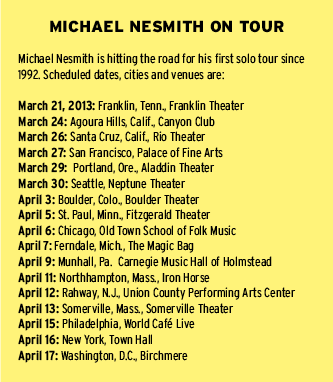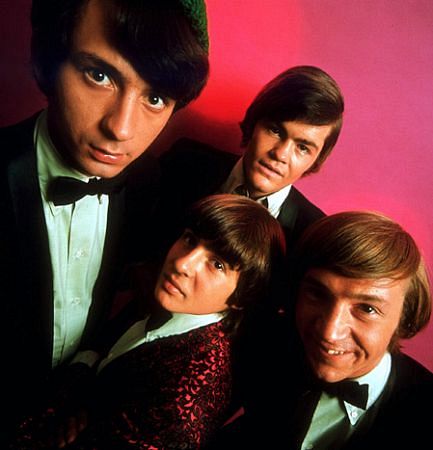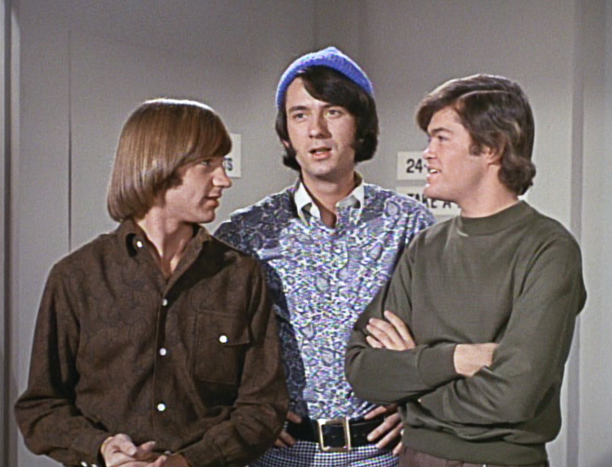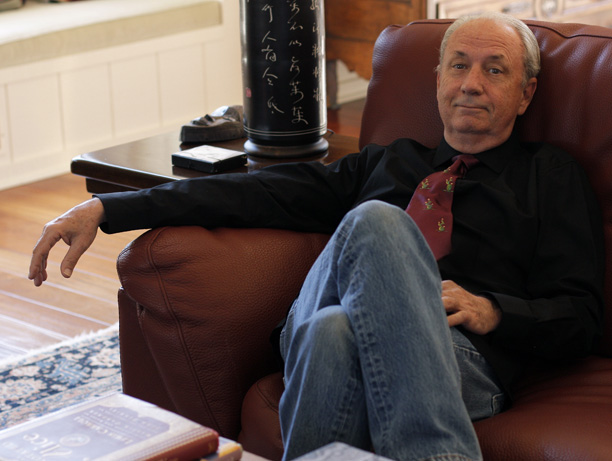Monkees Mike Nesmith plans first U.S. solo tour in 21 years
By Ken Sharp
In a career spanning five decades — his first single, “Wanderin” b/w “Well, Well” was issued in 1963 — Michael Nesmith has worn a lot of hats: Singer-songwriter, country-rock icon, actor, video pioneer, film producer, book author, philanthropist, and, of course, the proverbial “wool hat” as a member of The Monkees.
But in 2013, his loyal legion of fans are most excited by the hat he’s currently wearing, that of live performer. Many fans assumed he’d retired from live performing, but in October and November of 2012, Nesmith surprised everyone by embarking on not one but two tours, a short solo tour of the U.K. followed by a successful Monkees reunion with fellow surviving members Micky Dolenz and Peter Tork. (The band’s fourth member, Davy Jones, died unexpectedly Feb. 29, 2012, of a heart attack ).
Michael Nesmith’s 17-city tour begins March 21, 2013, in Franklin, Tenn. Publicity photo.
Marking his first U.S. solo dates in 21 years, Nesmith and his new band are gearing up for a 17-city, stateside solo jaunt, which kicks off March 21, in Franklin, Tenn. As a solo artist, the 70-year-old Texas native is lauded as a country-rock pioneer. His distinctive voice powered the seminal albums “Magnetic South,” “Nevada Fighter,” “Loose Salute,” “And The Hits Just Keep on Comin’,” “From a Radio Engine to the Photon Wing” and “Infinite Rider on the Big Dogma.”
 Michael Nesmith Tour DatesFrom “Mary, Mary” to “Some of Shelly’s Blues,” “Different Drum” to “Propinquity,” Nesmith’s songs have been covered by a gamut of artists, including Linda Ronstadt and The Stone Poneys, The Nitty Gritty Dirt Band, The Jayhawks, the Paul Butterfield Blues Band, Earl Scruggs, Paul Westerberg, Frankie Laine, The Lemonheads and Run-DMC. Goldmine caught up with Nesmith to get the scoop about what prompted him to go back out on the road, what’ it’s like being viewed as a country-rock pioneer and the story behind why Tommy Tedesco’s flying Telecaster took flight during a recording session with The Wrecking Crew.
Michael Nesmith Tour DatesFrom “Mary, Mary” to “Some of Shelly’s Blues,” “Different Drum” to “Propinquity,” Nesmith’s songs have been covered by a gamut of artists, including Linda Ronstadt and The Stone Poneys, The Nitty Gritty Dirt Band, The Jayhawks, the Paul Butterfield Blues Band, Earl Scruggs, Paul Westerberg, Frankie Laine, The Lemonheads and Run-DMC. Goldmine caught up with Nesmith to get the scoop about what prompted him to go back out on the road, what’ it’s like being viewed as a country-rock pioneer and the story behind why Tommy Tedesco’s flying Telecaster took flight during a recording session with The Wrecking Crew.
Goldmine: In 2012, we’ve seen your return to the stage both as a solo artist (with a short U.K. tour) and on a tour with The Monkees. What inspired you to play live again after a long absence?
 The surviving members of The Monkees — Michael Nesmith, Mickey Dolenz and Peter Tork — reunited for a brief tour in fall 2013. Now, Nesmith is preparing for a U.S. solo tour. Publicity photo/Rhino.
The surviving members of The Monkees — Michael Nesmith, Mickey Dolenz and Peter Tork — reunited for a brief tour in fall 2013. Now, Nesmith is preparing for a U.S. solo tour. Publicity photo/Rhino.Michael Nesmith: I found myself at loose ends, and with lots of options, late in 2010, and so I decided to go out and play live, since it had been so long, and I missed it. I mentioned this decision in a Facebook post, and offers came in that fit with the way I wanted to develop my playing, and so tours came together quickly.
GM: For those who’ll never experience the magic of a band connecting, a feeling you’ve likened as “being of one mind” with each other in a live setting, can you describe the feeling like when it all comes together?
MN: A live music performance is sui generis — I know of no other artistic effort that produces the same results with performer and audience. There are different types of live performance events, of course — plays, dance, stand-up. etc. — but the performance of music carries a unique connection between the players and the listeners. The best I can describe it is as a suspension of time, a moment that continues throughout a piece of live music that develops emotionally and holds everyone poised, rapt. Words like eternal, timeless, infinite, come close, but nothing fully describes the actual experience. Music sustains this moment in a way that is satisfying and exciting, holding everyone in the same place and time around a common feeling. It is remarkable to me that an experience like this is in such easy reach — so close and so natural.
GM: You have a new solo band — Boh Cooper on keyboards; Chris Scruggs on guitar, mandolin and pedal steel; Paul Leim on drums; and Joe Chemay on bass. What ingredient does each member contribute to the musical stew?
MN: The approach to pulling the band together was to explore the concept of each member taking over his “station,” like the elements of an orchestra. These are exceptional players and musicians, so handing each one of them the opportunity to control all the bass elements or all the treble elements or all the rhythm elements was new for them but it allowed them to reach beyond just playing a single part. This was made possible by the new technologies and virtual instruments and so forth. When Paul tackles the rhythm section of a song he can interweave and play parts in his performance that was impossible before these new tools came along. In the hands of real musicians these virtual instruments come to life in a way that is not possible to describe in print. I find it inspiring and deep — the boundaries of a band are pushed way beyond the usual limits and each member has the opportunity to contribute things that were simply out of reach in the past.
GM: In a recent Facebook post, when speaking about your solo show, you said “I’ve got the songs built in a cinematic setting.” Can you expand on that? How do you plan to translate that to an audience?
MN: The songs live like mini-movies in my mind. This happened after they were written and as they became mature and familiar to me. In concert, I will say a few words in the intro to the songs about those settings, so the audience can share them with me.
GM: You’re in the enviable position of being graced with a large body of quality work. What’s the criteria in deciding upon what songs to include in the set? What can fans can expect from the show itself? Will the shows retain the narrative thread that was a part of your U.K. concerts?
MN: The band itself played a big part. Few people I have talked to realize what extraordinary talents “session” musicians have. They are very different from orchestra players and concert performers, and they have an ability to play music at an astonishingly high level — flawlessly and soulfully and precisely. Giving the band members their own section to control — treble section, etc., — opened up an orchestral side and a new musicality that felt very natural for certain songs. It is extraordinary to have an ensemble of players who can render songs in almost any way possible, to have such a range of choices of presentation. I chose the songs as they came to life in rehearsals, the ones that took on new aspects of expression due to the expanded capabilities of the band members. The musical palette was the broadest I have ever worked with, and certain songs blossomed in ways that were obvious and compelling. We only touched the top surface of my songwriting over the years. I will only do one Monkees song — “Papa Gene’s Blues” — as our opener. But the songs we chose are from all the years after the ’60s. The narrative will follow the songs and is an important part of the show.
 GM: One of your most moving solo compositions is “Some of Shelly’s Blues,” which was covered by The Stone Poneys and The Nitty Gritty Dirt Band. Can you share the genesis of its creation?
GM: One of your most moving solo compositions is “Some of Shelly’s Blues,” which was covered by The Stone Poneys and The Nitty Gritty Dirt Band. Can you share the genesis of its creation?
MN: The genesis is apparent in the lyric: the sorrow and tension of an impending collapse of a relationship that is relieved and saved by a simple observation. The songs I write may have gotten a spark from something in my life, but they tend to emerge and live as complete ideas independent of a chain of events. The emotion that surrounds one person telling another they love them is easy to feel simply by thinking about it. It doesn’t need an actual scenario to play for it to have deep meaning. There was never a real Shelley.
GM: You’re rightfully lauded as a country-rock pioneer. Back in the ’60s, seemingly around the same time, there was an explosion of incredible bands merging country and rock — groups like Buffalo Springfield, latter-day Byrds, The Flying Burrito Brothers, Dillard & Clark, and later Poco and Eagles. From your perspective, can you explain this emergence of country-rock outfits drawing from the same trough? Were you keeping close tabs on those groups? And did they inspire you as well as validate the direction your muse was taking you?
MN: The winds that were blowing moved us all along. We each had different approaches — different tacks and different sails in the wind — but we mostly headed the same direction, just because of the push. I had no notion of country rock as a possible genre, although we used the phrase among ourselves as First National Band members — Red Rhodes and John Ware and John London. This was more to frame up and focus a feeling of playing. We weren’t conscious of this being innovative. It was fun to play like that, and there was plenty to say with it, and we enjoyed listening to it, to each other. I listened to all the bands you mentioned at some point, but not until some time after the form was well under way. We were all immersed in playing it and giving it voice; we only slowly discovered each other over time. Ideas come along like this regularly that push everyone along. No one controls it; no one leads it. Certainly, no one invents it. It is the moment when the songs start to sing the singers, and not the other way round. Everyone who plays and sings knows this when it happens, and it is the most fun I can have playing music. Like flying in your dreams, effortlessly — and especially fun if you find someone up there with you. You wave and smile and acknowledge the forces at work.
via Monkees Mike Nesmith plans first U.S. solo tour in 21 years | Goldmine Magazine.
 Follow us
Follow us Join us
Join us




Anyone going to the Birchmere show with Conversation Passes? It looks like I struck out as I never got a notice to order and haven’t heard back from the Ranch. I have an old painting I did that I’d love to get signed if anyone with passes would get for me, I’d be greatly appreciative.